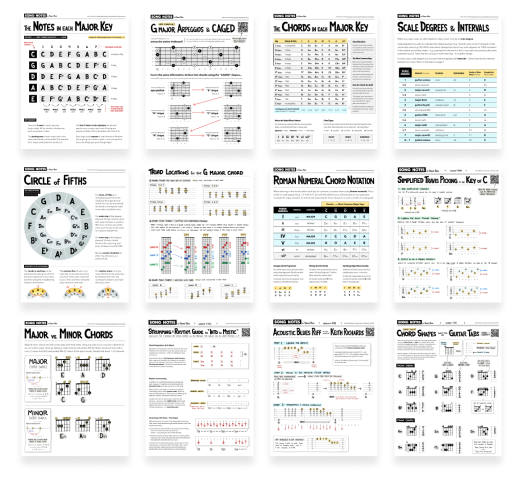7 Years
by Lukas Graham • Lesson #22 • Jun 26, 2016
Editor’s notes
Here’s my video lesson teaching 7 Years by Lukas Graham. It contains the chords, tablature, lyrics, and strumming pattern for the full song. I hope you find it helpful!
Free Video lesson
Song Sheet Temporarily Unavailable...
For copyright reasons, my printable song sheet is temporarily unavailable while I move it over to Musicnotes.com, a sheet music service that is providing licensing for my song arrangements.
Want me to priortize this song, so the song sheet is ready sooner? Click the button below and let me know – this helps me know which songs to work on next!
Click to RequestLearn more about my library of song sheets & instructional PDFs.
Chord progression cheat-sheet
The basic progression used for most of the song (verse & chorus sections) is as follows:
Em . . D/F# G . . . C . . . . . D .
There are a few exceptions:
- During the most minimal / soft intros, the D/F# is omitted (i.e., switch from the Em directly to a G). The first chorus is an example of this.
- At the end of some of the choruses, the final “D” isn’t played (stay on C). The first chord is an example of this.
- The bridge section during the “60 years old” portion uses different progression. See the notes below about this.
Notes & tabs
Basic chords used
E ||---0----3----0----2----
B ||---0----0----1----3----
G ||---0----0----0----2----
D ||---2----0----2----0----
A ||---2----2----3---------
E ||---0----3--------------
Em G C D
Intro riff
See PDF.
Playing chords at the start of the the walk-down
If you want to start the walk-down riff by strumming a chord (instead of a single note), use these tabs. This applies to the D-chord and G-chord.
See PDF.
Em-to-G Walk-up
A rather recognizable part of the chord progression involves this walk-up transition from Em to G, by means of adding a D-major chord with a F# bass note. Here are a few ways to play that.
At its simplest, we’re talking about this F# on the 2nd fret of the 6th string. You can play this note by itself between the two chords and capture the spirit of this walk-up.
See PDF for diagram.
Strictly speaking, the full chords in question look like this – but when all strings are played, I find the bass transition is drown out by the higher treble notes.
See PDF for diagram.
One way I like to play it is as follows – I’m playing only the 4-5 bottom strings, so that the transition is a bit more full sounding. If this is new to you, it’s important to recognize that the D/F# segment you’re playing is part of that “full” D/F# chord listed above.
See PDF for diagram.
Enjoy My Lessons? Show Your Support!
Most of the lessons on my website are 100% free. If you have the means, please show your support with a tip jar contribution. I put many hours into every lesson — but it only takes you a minute to make a donation. You have my thanks!
Looking for More Song Lessons?
Featured Courses
Fun & Helpful Tools I've Made
Coming soon is Jambox – which shows all the video jam tracks I've made. It's note quite ready for the spotlight, but check it out if you like!
Subscribe to my YouTube channel
Be sure to never miss a lesson by subscribing on YouTube. I put out 2-3 new videos every week. These include full song lessons, as well as covers, practice tips, behind-the-scenes updates. Thanks!
Recent Lessons
-
Dec 19, 2025
"Fairytale of New York" by The Pogues
-
Dec 12, 2025
"The Christmas Song" by Nat King Cole
-
Dec 4, 2025
"If I Needed You" by Emmylou Harris & Don Williams
-
Nov 21, 2025
Learn to Play "Hey Joe", Step-by-Step
-
Nov 15, 2025
Songs Using the One-Four-Five Chords
-
October 31, 2025
"Long Cool Woman (In a Black Dress)" by The Hollies
-
October 24, 2025
"Dust in the Wind" Intro Fingerstyle, Step-by-Step
-
Oct 18, 2025
"America" by Simon & Garfunkel
-
Oct 8, 2025
Rhythm Deep-Dive: "Wild World" by Cat Stevens


